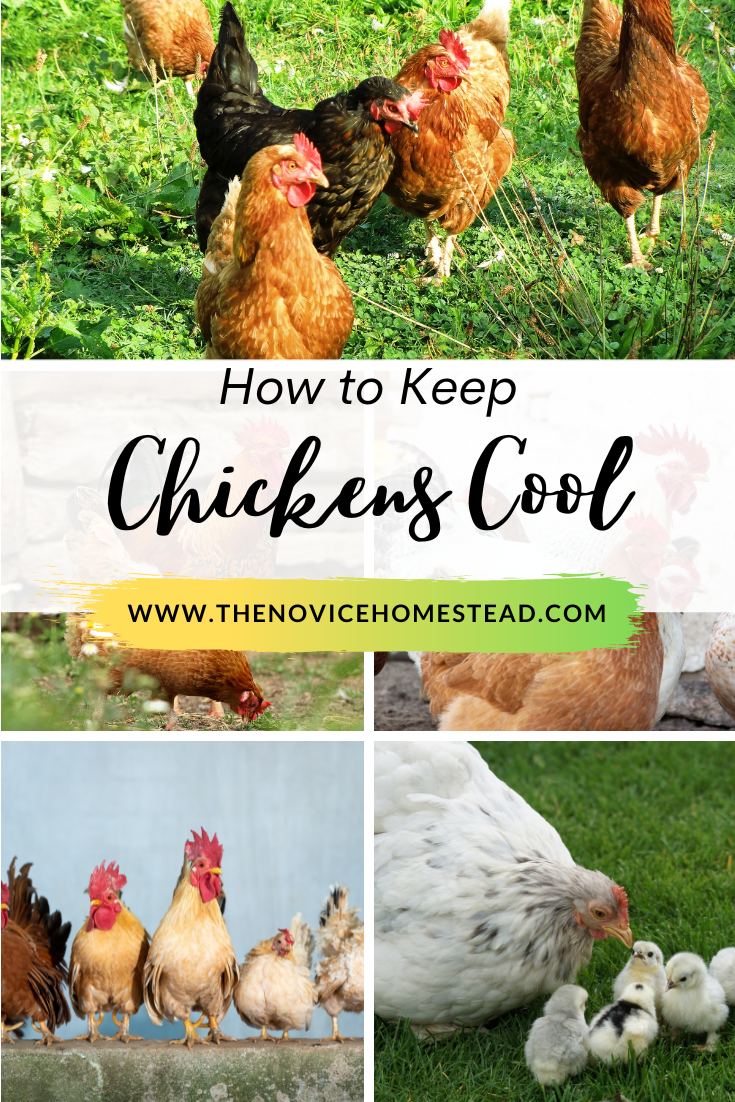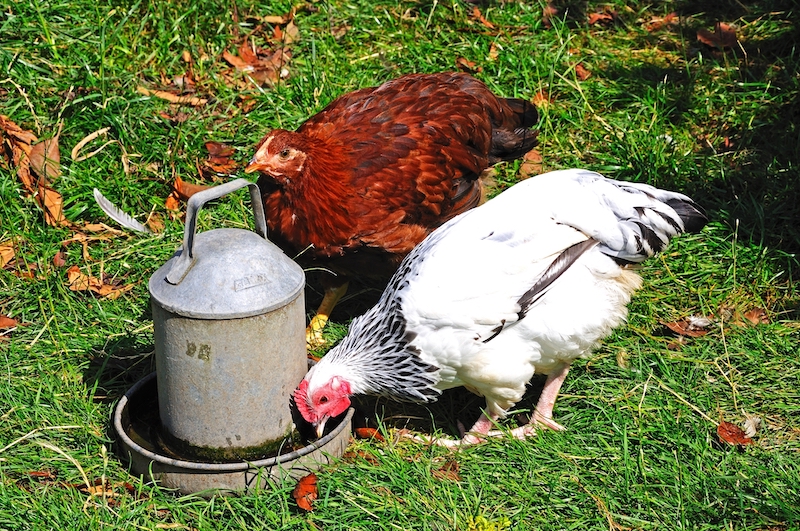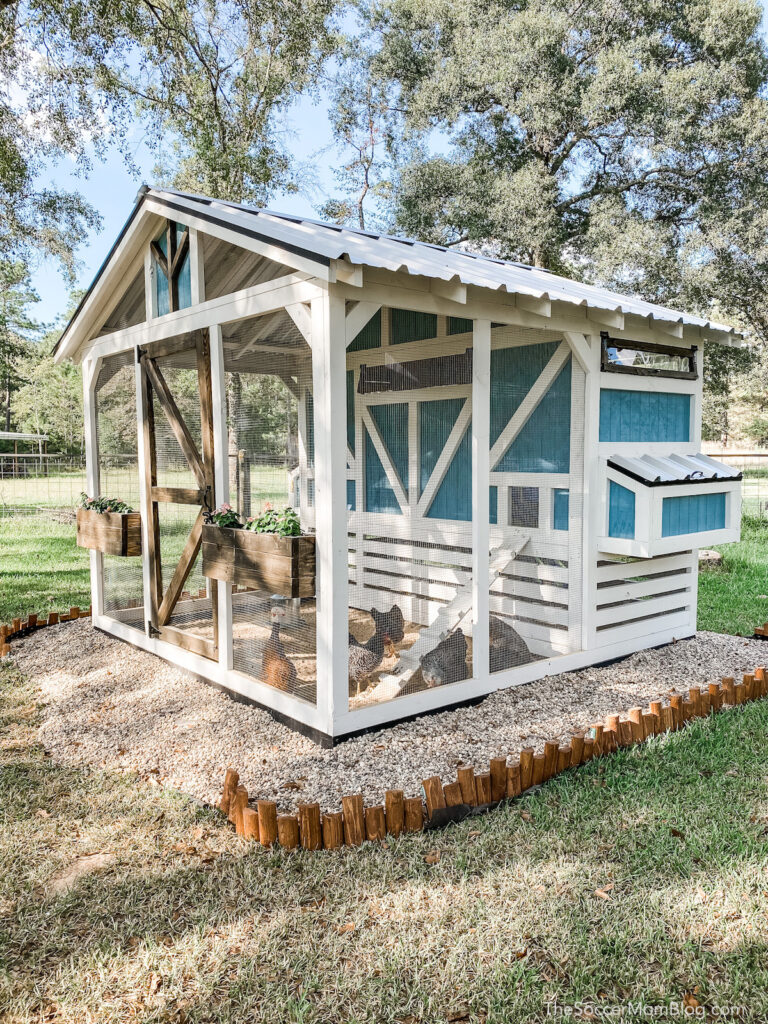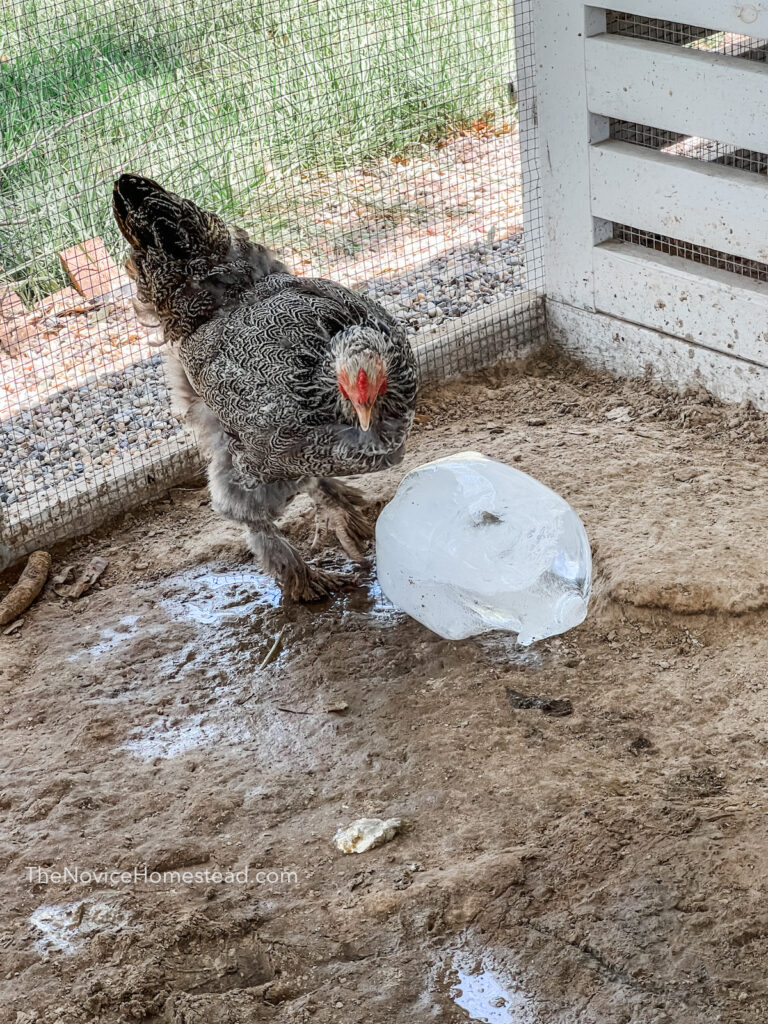Help your chickens beat the heat with these easy steps to keep chickens cool during hot weather.

It’s always hot during the summer in Texas, but this year we had a record-breaking heat wave. In fact, we’re still in the middle of it!
Earlier this week, we hit 106 degrees where we live. Combined with the humidity, the “feels like” temperature was even higher. Heat and humidity can create a dangerous combination when the base temperature is over 100 degrees.
So how do you protect your chickens from heat-related issues?
How Hot is Too Hot for Chickens?
When the outdoor temperatures surpass 85-90°F, you may notice that your chickens appear to pant, similar to how a dog would. They may also hold their wings out away from their bodies.
This is fairly normal chicken behavior in hot weather and is not necessarily cause for alarm, especially for large heavy breeds such as Brahmas or Orphingtons.
However, the following signs are more urgent:
- Pale or white combs
- Diarrhea
- Lethargic behavior
- Not eating or drinking
If you see any of your chickens with the above symptoms, they could very well be overheating and need immediate attention.
How to Keep Chickens Cool
You actually don’t need a lot of fancy equipment or special tricks to keep chickens cool during hot weather. A few basic steps will ensure that they are safe from the heat:
Water
This is the single most important thing to keep your chickens safe in the summer, or any time for that matter. Chickens should always have access to fresh water in their run. Drinking water is how chickens stay hydrated and helps regulate body temperature.
When chickens go into their coop to roost at night, they don’t need food or water. However, it should be immediately available outside in the run when the coop door opens in the morning. Depending on the size of your flock, you may want to add an extra waterer during the hotter months.

Shade
Next to water, shade is the most important way to keep your flock cool. Not only does shaded protect the chickens from direct sunlight, but it also lowers the temperature of that area.
Our entire run is shaded, with a roof. Also, when we built our coop, I planned the location so that it was in an area of our yard that would be shaded by two large trees. This helps keep their coop and run even cooler because the trees block a lot of the direct sunlight before it even hits the roof of the coop.
Do not count the coop itself as the shaded area for your chickens. The coop will be quite hot during the day, even with windows and doors open, because there is less airflow than the outdoors. Chickens also need a shaded area outside the coop.

Ventilation
This mainly applies to the coop/roosting area itself, as the run will have fresh air and hopefully a breeze to keep it ventilated.
If your coop has windows (it should have at least one!) keep them as open as possible during hot weather. Make sure that the windows and any openings are securely covered with hardware cloth to keep out predators.
We keep the windows open at night too, again, because the coop traps heat during the day and it needs to cool off at night. Of course, with screens made from hardware cloth.
Related: Learn more about how to predator-proof your chicken coop here!
I’ve heard of some chicken owners installing fans in their coop, but this shouldn’t be necessary if you have adequate shade and ventilation. Our coop does not have electricity, so we do not have fans, and our chickens have done fairly well despite the record-breaking heat in Texas!
Fresh Fruits & Veggies
Chickens should always have access to layer feed, no matter the weather. However, during hot months, you may want to supplement with fresh fruits and vegetables.
Fruits such as watermelon and cantaloupe are wonderful because they give the chickens a bit of sugar for energy and LOTS of hydration since these fruits have high water content. Cucumbers, blueberries, apples, and leafy greens are also favorites of our flock.
I don’t usually go buy them produce, but rather I save the things that we don’t eat: apples that have started to bruise, the extra watermelon or cantaloupe middle, etc.
You can also freeze bits of fruit and vegetables in ice, for an extra cool treat — like these frozen corn chicken treats we made.
A note about corn: There is an old wives tale that says corn causes chickens to get hot, but it is no different than other starchy foods that they eat. Food causes the metabolism to fire up, but it won’t make them overheat. In any case, you’re only giving them a small treat in an amount that wouldn’t make a significant impact anyway. Their normal feed should comprise the bulk of their nutrition.
Related: What foods can you feed chickens?
Sand or Dirt
One of the ways chickens will keep themselves cool in the summer is by burrowing into the dirt or sand. This is also what my dog likes to do (though we bring her inside if the temperature hits 95 degrees or higher).
Free access to loose sand or dirt is all chickens need and they will take care of the rest themselves.

Ice
One of the things I do for my chickens that they seem to truly love is make giant blocks of ice. I don’t do this every day in the summer, but anytime it’s over 100 degrees I do.
If you have a large silicone mold, you can use that. But an easy way to make ice blocks is to freeze a cheap gallon of water, then cut off the plastic.
I plop the big ice block down in the sand of the run and leave it. Over time, the ice melts and makes a cool puddle that the chickens like to play in. Each big block of ice lasts about 4-5 hours, which is just enough to last during the hottest part of the day.
I also add a handful of ice cubes to their waterer so it cools off a bit (it gets pretty warm during the day!) Chickens don’t need ice water though, as ice cold water actually has the opposite effect of raising body temperature as the body tries to warm the cold water when drinking it.
What NOT to Do:
- Bring your chickens inside (unless they are sick) — Animals acclimate to the weather and bringing them into an air conditioned house means they will become used to the cold temperatures. When you take them back outside, they might suffer MORE from the heat because they are not used to it anymore.
- Leave your chickens unattended — Chickens are fairly easy to keep, especially if you have an automatic door. Leave them food and water and they should be good to go a for a day or two…under normal conditions. But a heat wave is not the time to leave your chickens alone. If you have a vacation planned, make sure that you have someone to check on your animals at least once a day.
- Put Your Chickens in a Swimming Pool or Pond — Chickens like to play in water and mud puddles, like the ones made when our ice blocks melt. They can swim a little, but not for long periods of time, so DO NOT drop them into a swimming pool, pond, or lake to cool them off. They could drown.
What to do if Your Chicken Overheats
The first course of action if your chicken is overheating is to get them out of the heat and out of the sunlight. Immediately.
Just like in humans, heat stroke can be deadly in chickens.
Of course, if a human is in distress, you’d call the ambulance. However, often with backyard chickens, we are the first line of help. Most of the veterinarians in my area don’t know much about chickens at all!
If you have a trusted vet, you may want to consult them. Keep in mind that I am not a vet myself and everything I’ve learned is from living it! I have to take care of chicken-related problems myself to the best of my ability.
If you don’t have access to a vet that is experienced in poultry or just don’t have the ability to get to a vet in time, taking these steps could save your chicken’s life. And I feel like it is better to try yourself than do nothing if a vet is not available!
The first thing to do for an overheated chicken is to bring them into a shaded area that is well ventilated.
To further cool their body temperature, you may try submerging them in cool water. NOT ice water.
Start slowly, with their feet first. Gradually lower them further into the water, up to their neck. Doing this too quickly can be a shock to their system, so it is a balance of cooling them off fairly quickly, but not all at once.
When your chicken regains their color and seems like they are “back to normal” you can return them to the flock. But be sure you’ve fixed what caused them to overheat in the first place, such as a lack of adequate shade.
If your chicken is slow to recover, you may want to keep them separate from the flock and under observation. Again, keep them in a cool place.